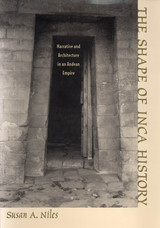3 books about Contributions in architecture

The Petrine Revolution in Russian Architecture
James Cracraft
University of Chicago Press, 1988
In this highly original book James Cracraft provides a major case study of the cultural revolution in Russia initiated by Peter the Great, tsar and first emperor (1682-1725). He recounts in fascinating detail how modern standards of architecture supplanted traditional norms in Russia following a massive injection of European expertise and indicates how, thereby, the modern Russian built world came into being. The first comprehensive study of the Petrine revolution in Russian architecture to be published in any language, the book includes nearly 250 illustrations, many of them original photographs appearing here for the first time.
[more]

The Shape of Inca History
Narrative and Architecture in an Andean Empire
Susan A. Niles
University of Iowa Press, 1999
In The Shape of Inca History, Susan Niles considers the ways in which the Inca concept of history informed their narratives, rituals, and architecture. Using sixteenth-century chronicles of Inca culture, legal documents from the first generation of conquest, and field investigation of architectural remains, she strategically explores the interplay of oral and written histories with the architectural record and provides a new and exciting understanding of the lives of the royal families on the eve of conquest.
Niles focuses on the life of Huayna Capac, the Inca king who ruled at the time of the first European incursions on the Andean coast. Because he died just a few years before the Spaniards overturned the Inca world, eyewitness accounts of his deeds as recorded by the invaders can be used to separate fact from propaganda. The rich documentary sources telling of his life include extraordinarily detailed legal records that inventory lands on his estate in the Yucay Valley. These sources provide a basis—unique in the Andes—for reconstructing the social and physical plan of the estate and for dating its construction exactly.
Huayna Capac's country palace shows a design different from that devised by his ancestors. Niles argues that the radical stylistic and technical innovations documented in the buildings themselves can be understood by referring to the turbulent political atmosphere prevalent at the time of his accession. Illustrated with numerous photographs and reconstruction drawings, The Shape of Inca History breaks new ground by proposing that Inca royal style was dynamic and that the design of an Inca building can best be interpreted by its historical context. In this way it is possible to recreate the development of Inca architectural style over time.
[more]

The Villas of Pliny from Antiquity to Posterity
Pierre de la Ruffinière du Prey
University of Chicago Press, 1994
Pierre de la Ruffinière du Prey traces the influence of Pliny the Younger as a continuous theme throughout the history of architecture. First he looks at what Pliny considered to be the essential qualities of a villa. He then discusses the many buildings Pliny inspired: from the Renaissance estates of the Medici, to papal summer residences near Rome, to Thomas Jefferson's Monticello, and the home of former Canadian prime minister Pierre Elliott Trudeau. Equally important to du Prey's study are the many designs by architects past and present that remain on paper. These imaginary restitutions of Pliny's villas, each representative of its own epoch, trace in microcosm the evolution of the classical tradition in domestic architecture. In analyzing each project, du Prey illuminates the work of such great masters as Michelozzo, Raphael, Palladio, and Schinkel, as well as such well-known modern architects as Léon Krier, Jean-Pierre Adam, and Thomas Gordon Smith.
[more]
READERS
Browse our collection.
PUBLISHERS
See BiblioVault's publisher services.
STUDENT SERVICES
Files for college accessibility offices.
UChicago Accessibility Resources
home | accessibility | search | about | contact us
BiblioVault ® 2001 - 2024
The University of Chicago Press









